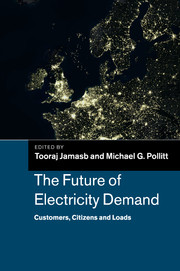Book contents
- Frontmatter
- Contents
- List of Figures
- List of Tables
- List of Boxes
- List of Contributors
- Foreword
- Preface
- Acknowledgements
- Introduction and overview of the chapters
- Part I The economics
- Part II Technology
- Part III Social dimensions
- Part IV Policy and regulation
- 14 Demand-side management strategies and the residential sector: lessons from the international experience
- 15 Electricity distribution networks: investment and regulation, and uncertain demand
- 16 The potential impact of policy and legislation on the energy demands of UK buildings and implications for the electrical network
- 17 The ADDRESS European Project: a large-scale R&D initiative for the development of active demand
- 18 Daylight saving, electricity demand and emissions: the British case
- 19 Concluding reflections on future active networks and the demand-side for electricity
- Index
- References
15 - Electricity distribution networks: investment and regulation, and uncertain demand
from Part IV - Policy and regulation
Published online by Cambridge University Press: 05 March 2014
- Frontmatter
- Contents
- List of Figures
- List of Tables
- List of Boxes
- List of Contributors
- Foreword
- Preface
- Acknowledgements
- Introduction and overview of the chapters
- Part I The economics
- Part II Technology
- Part III Social dimensions
- Part IV Policy and regulation
- 14 Demand-side management strategies and the residential sector: lessons from the international experience
- 15 Electricity distribution networks: investment and regulation, and uncertain demand
- 16 The potential impact of policy and legislation on the energy demands of UK buildings and implications for the electrical network
- 17 The ADDRESS European Project: a large-scale R&D initiative for the development of active demand
- 18 Daylight saving, electricity demand and emissions: the British case
- 19 Concluding reflections on future active networks and the demand-side for electricity
- Index
- References
Summary
Introduction
Electricity distribution networks are highly capital-intensive systems and timely investments to maintain and upgrade the assets are crucial for long-term reliability and expansion of their service. In the coming years, in the UK, and elsewhere in Europe, many distribution networks will be in need of extensive investments in their aging assets. At the same time, aspects of energy policy concerning climate change, renewable energy sources, energy efficiency, demand-side management (DSM), network energy loss reduction, quality of service standards and even security of supply (Jamasb and Pollitt, 2008) require active, flexible and smart networks that can be achieved only through significant investments.
At the same time, the utilities’ investment decisions are dependent on the regulatory framework within which they operate. Following the liberalization of the electricity sectors around the world, the introduction of incentive regulation regimes based on RPI-X models and benchmarking has in most cases improved the efficiency of network utilities. Cost savings can be achieved in operation and maintenance (Opex) and in capital expenditures (Capex). Evaluation of the efficiency potential in Capex is a challenging task. The main difficulty in incentivizing investments is in the discrepancy between the long economic life and the cyclical nature of network assets on the one hand and the considerably shorter (five years in the UK) distribution price control periods on the other. Here both better planning and implementation of investments, or a mere reduction in investments, can appear as achieving efficiency improvement in the short and medium term while the implications of under-investment become apparent in the long run.
- Type
- Chapter
- Information
- The Future of Electricity DemandCustomers, Citizens and Loads, pp. 379 - 400Publisher: Cambridge University PressPrint publication year: 2011
References
- 2
- Cited by



